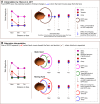Approaching threatening stimuli cause an expansion of defensive peripersonal space
- PMID: 28539400
- PMCID: PMC5626904
- DOI: 10.1152/jn.00316.2017
Approaching threatening stimuli cause an expansion of defensive peripersonal space
Abstract
When sudden environmental stimuli signaling threat occur in the portion of space surrounding the body (defensive peripersonal space), defensive responses are enhanced. Recently Bisio et al. (Bisio A, Garbarini F, Biggio M, Fossataro C, Ruggeri P, Bove M. J Neurosci 37: 2415-2424, 2017) showed that a marker of defensive peripersonal space, the defensive hand-blink reflex, is modulated by the motion of the eliciting threatening stimulus. These results can be parsimoniously explained by the continuous monitoring of environmental threats, resulting in an expansion of defensive peripersonal space when threatening stimuli approach.
Keywords: blink reflex; defense; movement; peripersonal space.
Copyright © 2017 the American Physiological Society.
Figures

Comment on
-
Dynamic Shaping of the Defensive Peripersonal Space through Predictive Motor Mechanisms: When the "Near" Becomes "Far".J Neurosci. 2017 Mar 1;37(9):2415-2424. doi: 10.1523/JNEUROSCI.0371-16.2016. Epub 2017 Feb 2. J Neurosci. 2017. PMID: 28154151 Free PMC article.
Similar articles
-
Dynamic Shaping of the Defensive Peripersonal Space through Predictive Motor Mechanisms: When the "Near" Becomes "Far".J Neurosci. 2017 Mar 1;37(9):2415-2424. doi: 10.1523/JNEUROSCI.0371-16.2016. Epub 2017 Feb 2. J Neurosci. 2017. PMID: 28154151 Free PMC article.
-
Gravitational cues modulate the shape of defensive peripersonal space.Curr Biol. 2016 Nov 7;26(21):R1133-R1134. doi: 10.1016/j.cub.2016.09.025. Curr Biol. 2016. PMID: 27825445 Free PMC article.
-
Modulation of exteroceptive electromyographic responses in defensive peripersonal space.J Neurophysiol. 2019 Apr 1;121(4):1111-1124. doi: 10.1152/jn.00554.2018. Epub 2019 Feb 27. J Neurophysiol. 2019. PMID: 30811266
-
Action-dependent plasticity in peripersonal space representations.Cogn Neuropsychol. 2008 Oct-Dec;25(7-8):1099-113. Cogn Neuropsychol. 2008. PMID: 19378416 Review.
-
How many peripersonal spaces?Neuropsychologia. 2015 Apr;70:327-34. doi: 10.1016/j.neuropsychologia.2014.11.018. Epub 2014 Nov 20. Neuropsychologia. 2015. PMID: 25448854 Review.
Cited by
-
The effect of prepulse amplitude and timing on the perception of an electrotactile pulse.Atten Percept Psychophys. 2024 Apr;86(3):1038-1047. doi: 10.3758/s13414-022-02597-x. Epub 2022 Nov 16. Atten Percept Psychophys. 2024. PMID: 36385671 Free PMC article.
-
Looming Angry Faces: Preliminary Evidence of Differential Electrophysiological Dynamics for Filtered Stimuli via Low and High Spatial Frequencies.Brain Sci. 2024 Jan 19;14(1):98. doi: 10.3390/brainsci14010098. Brain Sci. 2024. PMID: 38275518 Free PMC article.
-
The physiological correlates of interpersonal space.Sci Rep. 2021 Jan 28;11(1):2611. doi: 10.1038/s41598-021-82223-2. Sci Rep. 2021. PMID: 33510396 Free PMC article.
-
Frontier of Self and Impact Prediction.Front Psychol. 2018 Jun 27;9:1073. doi: 10.3389/fpsyg.2018.01073. eCollection 2018. Front Psychol. 2018. PMID: 29997556 Free PMC article. Review.
-
Movement of environmental threats modifies the relevance of the defensive eye-blink in a spatially-tuned manner.Sci Rep. 2019 Mar 6;9(1):3661. doi: 10.1038/s41598-019-40075-x. Sci Rep. 2019. PMID: 30842481 Free PMC article.
References
Publication types
MeSH terms
LinkOut - more resources
Full Text Sources
Other Literature Sources

